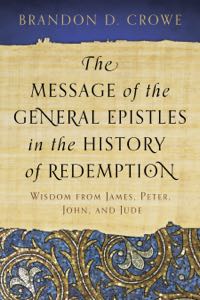How well acquainted are you with the “General Epistles” of the New Testament? Do you know which ones they are or what they are all about? Well, if the General Epistles are not your strongest suit, you have much company. And so it is well worth our noting when New Testament professor Brandon Crowe of Westminster Theological Seminary produces a book on the subject. Today he’s here to talk to us about his new book.
Books At a Glance (Fred Zaspel):
First, perhaps you could just introduce your book to us. What is it all about? And what do you hope to accomplish? Who is your intended audience?
Crowe:
 The Message of the General Epistles is a biblical-theological study of James through Jude, but it also emphasizes the urgency of the call to discipleship in these letters. My aim is to help readers live more faithfully in the present age in light of the distinctive emphases of the General Epistles. I have written the book in a way that will be accessible to audiences without any formal training. Thus, it would be suitable for personal study or use in a Sunday School or small group setting. But I think it is distinctive enough that it would also be suitable for a classroom setting. It would also be a handy resource for pastors preaching on these books, helping them become acquainted or re-acquainted with the theological message of these letters.
The Message of the General Epistles is a biblical-theological study of James through Jude, but it also emphasizes the urgency of the call to discipleship in these letters. My aim is to help readers live more faithfully in the present age in light of the distinctive emphases of the General Epistles. I have written the book in a way that will be accessible to audiences without any formal training. Thus, it would be suitable for personal study or use in a Sunday School or small group setting. But I think it is distinctive enough that it would also be suitable for a classroom setting. It would also be a handy resource for pastors preaching on these books, helping them become acquainted or re-acquainted with the theological message of these letters.
There are a lot of complicated questions one may encounter in commentaries and discussions of these letters, and sometimes it is easy to miss the forest for the trees. In this volume I leave most of those more technical questions to the side, and instead focus on mining the practical fruit from these letters.
Books At a Glance:
Compared to Paul’s epistles, the General Epistles are relatively unfamiliar to many Christians. Why is that?
Crowe:
That’s a good question, and one that probably has many answers. One reason is surely because Paul wrote 13 letters, so we have so much more of his corpus than we do for most authors of the General Epistles. And, of course, there is plenty to keep us busy in Paul. But another reason is probably because of how strange the General Epistles can seem to us. It may not be readily apparent how to handle texts about angels kept in chains of gloomy darkness. What do we make of Michael arguing with the devil about the body of Moses? How helpful is it to use James’s language that we are justified by our works and not by faith alone, when it seems to be so different to Paul? Passages such as these can be confusing, and they may not fit snugly into the ways we often talk about theology. Combine this strangeness with their location tucked in at the end of the New Testament, and it seems to be a recipe for a portion of Scripture that often deserves more attention.
Books At a Glance:
Give us some broad characterizations of the General Epistles. What distinguishes them? And what is their distinctive place or role in the canon?
Crowe:
These letters were written to churches that were facing tough situations because of their faith. One gets the sense that the churches were grasping for wisdom to address complex questions they were facing. These letters were therefore written for practical guidance, built upon mature reflections on the work of Christ. The General Epistles encourage perseverance in faith in the present age, as we look forward to the return of Christ.
Books At a Glance:
The way you have divided your material is certainly eye-catching: “Scallywags, Scoffers, Schisms, Wisdom for Life”! Would you sort this out for us?
Crowe:
I hope that if readers remember these alliterative terms, they can remember the message of these epistles. I use “scallywags” to refer to the way the world views Christians in 1 Peter. A scallywag is a rogue, a troublemaker, a ne’er do well. In 1 Peter Christians are facing opposition unjustly because of their commitment to Christ. The point is, although the world views them as scallywags, Peter makes it clear they are actually beloved by God.
“Scoffers” refers to those who scoff at the return of Christ and the law of God in 2 Peter and Jude, promoting an ungodly lifestyle. We must be warned about them.
“Schisms” refers to divisions that arise in the church, and applies primarily to 1–3 John in this volume. The schismatics, or leaders of the schisms, promoted other ways to be “spiritual” and led people astray from the apostolic teaching. John tells us that such divisions arise to make clear who are and who are not true followers of Christ.
Books At a Glance:
What might these epistles have to say to the postmodern mind?
Crowe:
I believe these epistles have much to say to the world today (as Vern Poythress also points out in his foreword to the book). First, false teaching is real and is deathly serious. We should not be surprised to find false teaching in the church today, but we should expect it. And when we do encounter it, we must not be fooled to think that it does not matter. False teaching is an urgent matter that poses a dire threat.
Second, these letters teach us that our actions really matter. Our works do not save us, but they are necessary fruits of salvation. Therefore we ought to seek diligently to grow in holiness. It is striking that one of the primary ways we see this in these letters is in the worldly, “anything goes” sexual ethic. These letters are clear that the sexual ethics of Christians must reflect the holiness of God’s character.
Books At a Glance:
What are some of the heresies addressed in these epistles that are prominent issues still today?
Crowe:
One example is the denial that our call to discipleship is necessary for salvation. To be sure, there is a balance that must be struck here between the indicative and imperative. But there seems to be the view in the background of many of these letters that our actions do not matter if we are saved by grace. But these letters teach us that such a view is explicitly disallowed by Scripture: with the manifold grace of God comes the real call to discipleship that is not up for debate.
Another example is the denial of Christ’s propitiatory suffering on the cross. In 1 John the spirit of the antichrist is seen in those who deny the real, bodily suffering of Jesus Christ. But John confirms that the bodily suffering of Christ is necessary for the forgiveness of sins, even if it is an embarrassment in the eyes of the world.
One more error would be the denial that Jesus is coming back. The scoffers promoted the view that Christ’s return was a myth, and that therefore there is no coming judgment. But 2 Peter corrects such a view, and tells us that one’s eschatology and ethics are interrelated.
Books At a Glance:
Explain for us what you mean by “the indicative and the imperative” of the gospel, as you have just mentioned. You make use of this in your book – how is this particularly relevant to these epistles?
Crowe:
The indicative refers to the God’s definitive work of salvation for us in Christ. The imperative refers to the call to follow Christ and obey his commands. The indicative is always logically prior to the imperative, yet they are always a package deal.
These two terms are also key to the structure of the book. For each letter I will walk the reader through the presence and relationship of the indicative and imperative. Some of these letters may emphasize the imperative more than the indicative, but even so, they are built upon the presupposition of the indicative. Keeping these concepts clear is crucially important to keep us from the errors of both antinomianism and legalism.
Books At a Glance:
Do you have any other books in the works that we can look for?
Crowe:
I am finishing up a couple of projects that your readers may be interested in. First is a book on the exegetical and practical necessity of the Trinity, co-edited with Carl Trueman. The first half of the book will engage in a Trinitarian reading of each corpus of the New Testament, along with one essay on the Old Testament. The second half will tease out practical implications of Trinitarian doctrine. We’ve been blessed with some outstanding contributors, and it should release next summer.
The other volume to look for is a theology of the life of Jesus in the Gospels, which I also anticipate releasing in 2016. This will be a bit more technical than the General Epistles volume. In it I will argue that the Gospel writers are presenting the obedient life of Jesus as necessary for the accomplishment of salvation. It interacts with both the history of interpretation and recent scholarship. It should be of interest for seminary and graduate students, pastors, professors, and anyone interested in the theology and soteriology of the Gospels.
Thanks for the questions, and for the opportunity to share with your readers at Books at a Glance.

